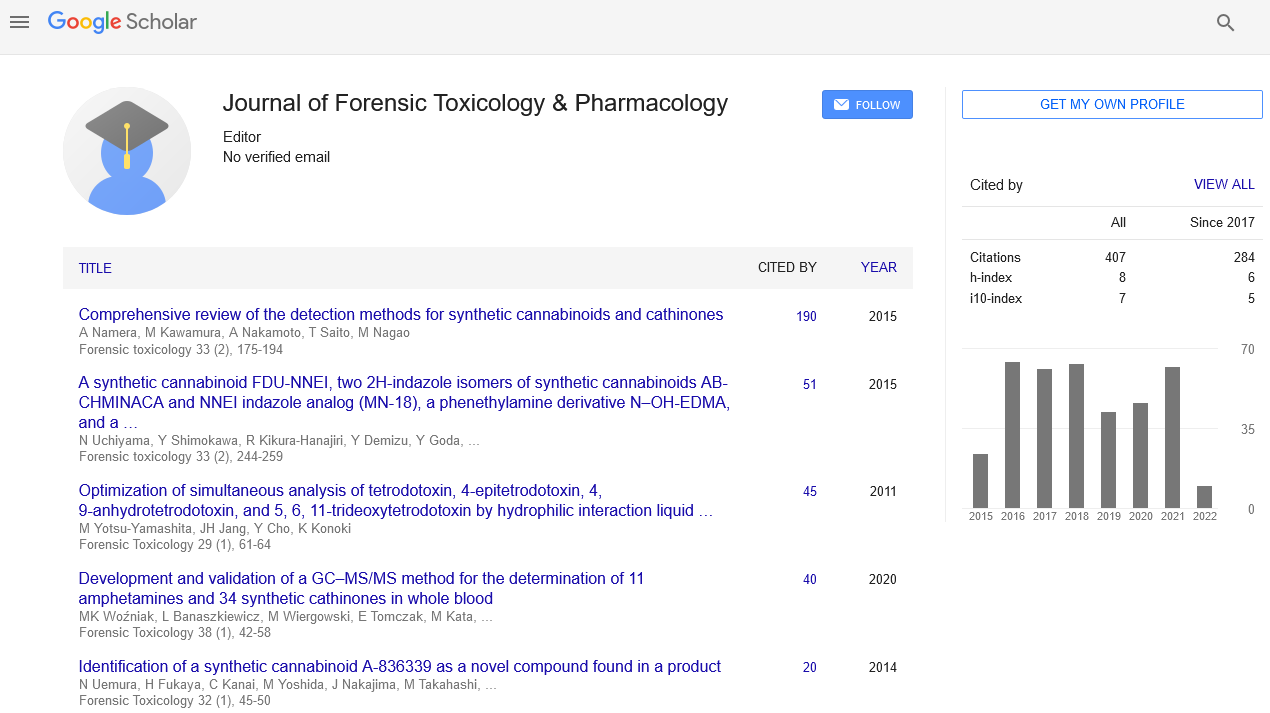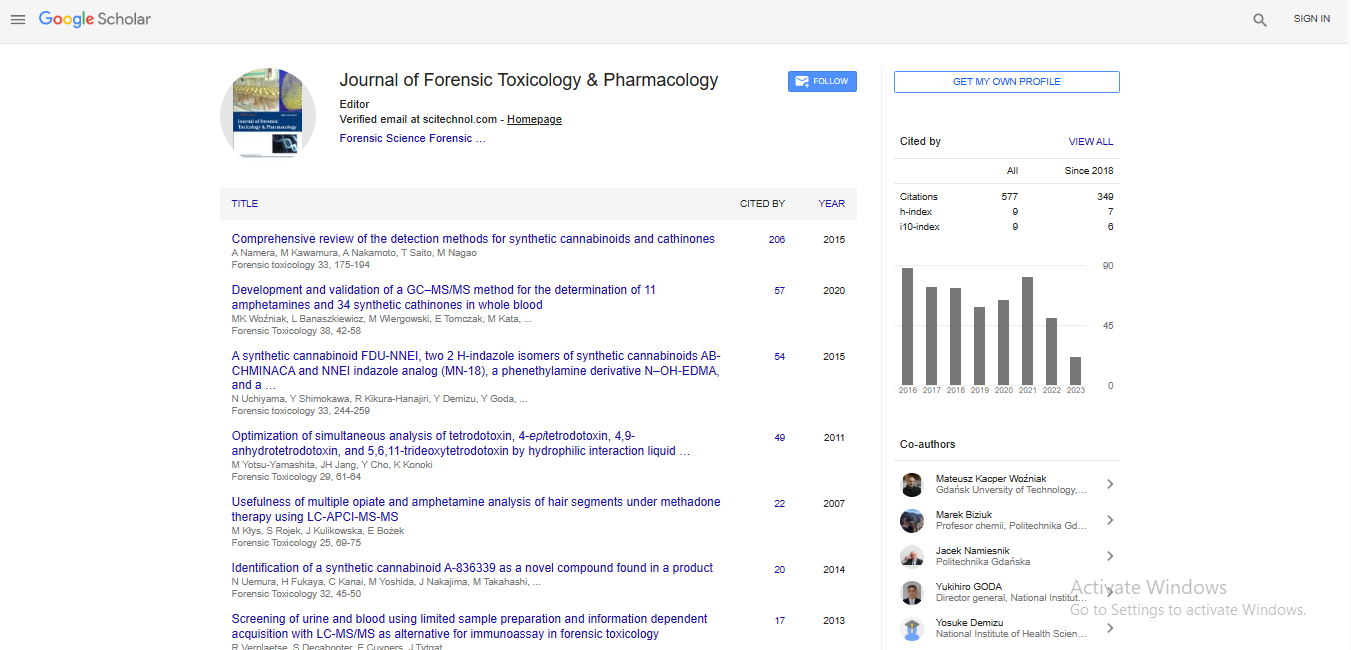Perspective, J Forensic Toxicol Pharmacol Vol: 13 Issue: 3
Blood-Brain Barrier: Toxicological Implications of Neuroactive Drugs on the Central Nervous System
Fatima Al-Muharraqi*
1Department of Pharmacology, King Saud University, Riyadh, Saudi Arabia
*Corresponding Author: Fatima Al-Muharraqi,
Department of Pharmacology, King
Saud University, Riyadh, Saudi Arabia
E-mail: muharraqifatima@gmail.com
Received date: 26 August, 2024, Manuscript No. JFTP-24-151883;
Editor assigned date: 28 August, 2024, PreQC No. JFTP-24-151883 (PQ);
Reviewed date: 11 September, 2024, QC No JFTP-24-151883;
Revised date: 18 September, 2024, Manuscript No. JFTP-24-151883 (R);
Published date: 25 September, 2024, DOI: 10.4172/JFTP.1000195
Citation: Al-Muharraqi F (2024) Blood-Brain Barrier: Toxicological Implications of Neuroactive Drugs on the Central Nervous System. J Forensic Toxicol Pharmacol 13:3.
Description
The Blood-Brain Barrier (BBB) serves as a critical boundary for the Central Nervous System (CNS), maintaining a selective environment to regulate the entry of substances and protect neural tissues. This highly selective structure restricts most compounds from entering the brain, yet many neuroactive drugs are specifically designed to cross it to achieve their intended therapeutic effects. However, as neuroactive agents enter the brain, their interactions can carry risks. The physiological impact of these drugs raises important toxicological concerns, including neurotoxicity, oxidative stress and disruptions to cellular health within the CNS.
The composition of the BBB consists of endothelial cells with tight junctions, astrocytes and pericytes that collectively control the movement of molecules into the brain. While neuroactive drugs, such as antidepressants, antipsychotics and stimulants, can navigate this barrier to exert their effects on neural circuits, they may also lead to adverse effects within this delicate environment. For instance, excessive or prolonged exposure to certain neuroactive drugs has been associated with potential toxicity that could lead to neurological complications over time.
The neurotoxic potential of neuroactive drugs emerges as a significant concern, as some compounds may alter normal cell function, potentially resulting in cell death or dysfunction. Neurotoxicity may occur when drugs interact with neuronal receptors, ion channels, or signal pathways in ways that overstimulate or disrupt these systems. For example, glutamate-based drugs or agents that modulate dopamine levels may induce excitotoxicity, a condition characterized by excessive activation of neurons. This hyperactivation can lead to cell damage and ultimately neuronal death, which, if sustained, can manifest in cognitive or motor impairment.
In some cases, drugs targeting the CNS may affect glial cells, such as astrocytes and microglia, that play supportive roles in maintaining neural health. Interactions with these cells can lead to inflammatory responses within the CNS, releasing pro-inflammatory cytokines that may contribute to neuroinflammation. This inflammatory state has been implicated in the progression of neurodegenerative diseases like Parkinson’s and Alzheimer’s, linking chronic drug exposure with long-term CNS changes.
Beyond direct neurotoxicity, many neuroactive drugs have been shown to induce oxidative stress within the CNS. Oxidative stress occurs when there is an imbalance between Reactive Oxygen Species (ROS) and the body’s antioxidant defenses, leading to cellular damage. Within the brain, neurons are particularly vulnerable to oxidative stress due to their high metabolic activity and limited regenerative capacity. Drugs such as antipsychotics and certain mood stabilizers can increase ROS production, which may impair mitochondrial function and reduce cellular energy availability. This disruption can impact synaptic plasticity and neuronal signaling, impairing cognitive and motor abilities.
Mitochondria, often described as the powerhouse of the cell, play a key role in cellular energy production and regulation of apoptosis, the process of programmed cell death. When neuroactive drugs compromise mitochondrial function, neurons may experience reduced energy, leaving them susceptible to damage. Mitochondrial dysfunction has also been linked to neurodegenerative conditions, further underlining the need for cautious use of neuroactive drugs with known oxidative properties.
Long-term alterations in neurochemistry also pose risks of mood disorders, cognitive decline, or other psychological symptoms. In particular, drugs that alter serotonin pathways may affect mood regulation, sleep and appetite, which could impact overall mental health over time. As drug levels fluctuate within the CNS, individuals may experience withdrawal symptoms, further affecting mental wellbeing and increasing the likelihood of relapse in patients attempting to discontinue the drug.
Neuroactive drugs play a vital role in treating numerous CNS disorders, yet their capacity to cross the BBB introduces complex toxicological challenges. Understanding these effects is important, not only to improve therapeutic efficacy but also to minimize the risks associated with neurotoxicity, oxidative stress and altered neurochemistry. As research continues to analyze safer delivery methods and targeted approaches, a comprehensive understanding of the toxicological implications will be essential to refine treatments that balance benefits with potential risks to the CNS.
 Spanish
Spanish  Chinese
Chinese  Russian
Russian  German
German  French
French  Japanese
Japanese  Portuguese
Portuguese  Hindi
Hindi 
